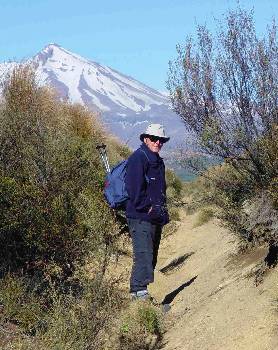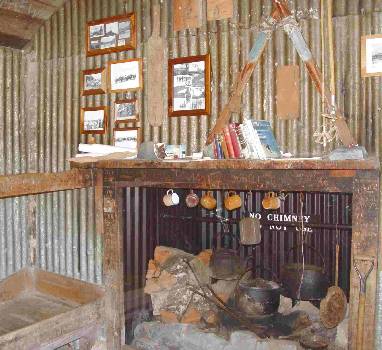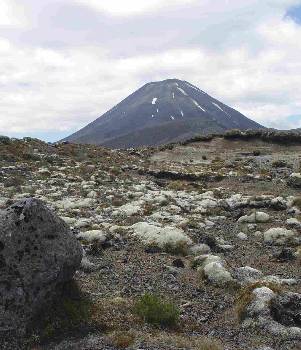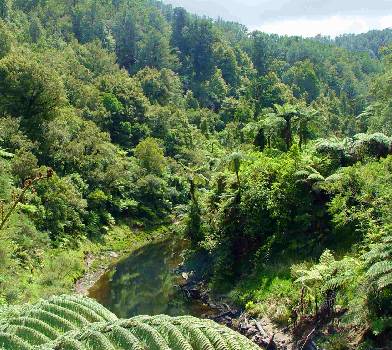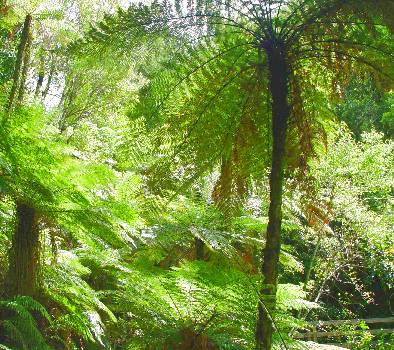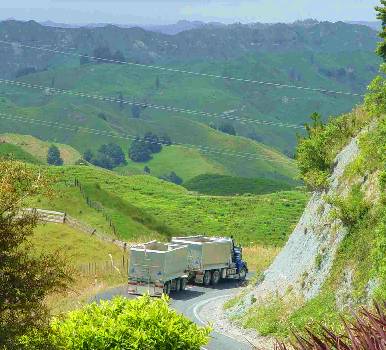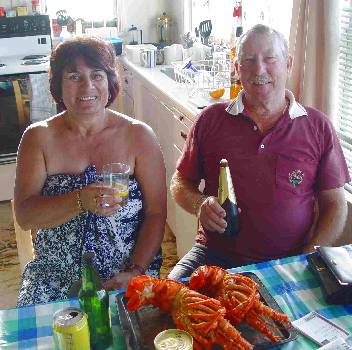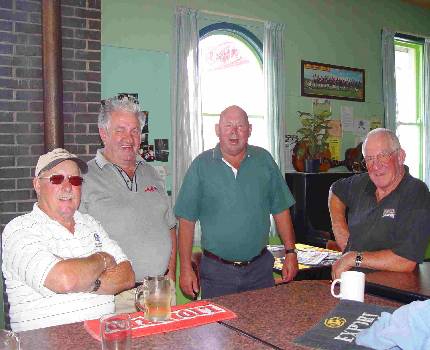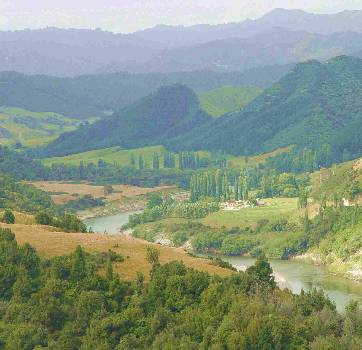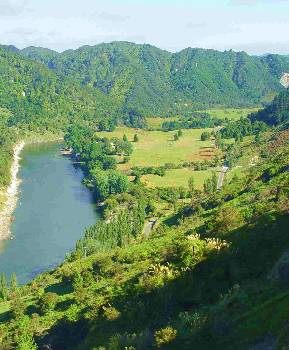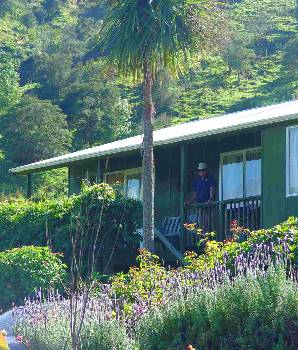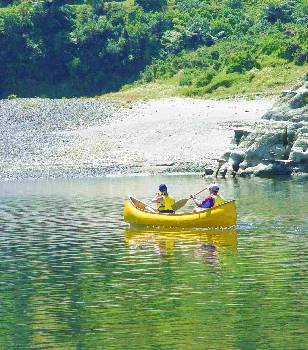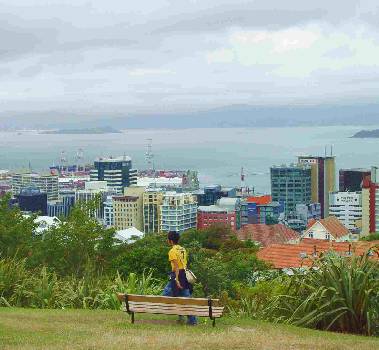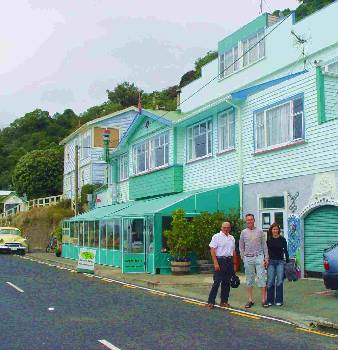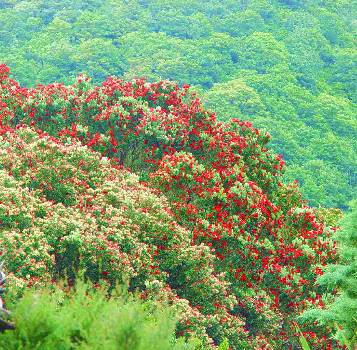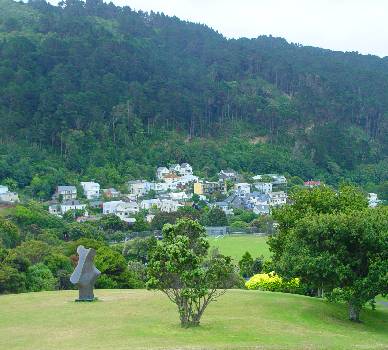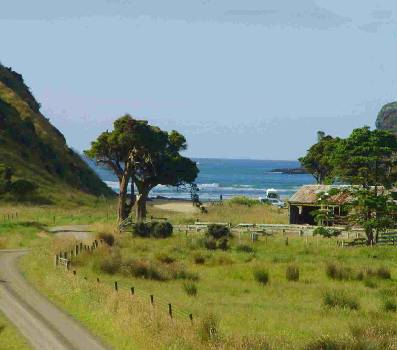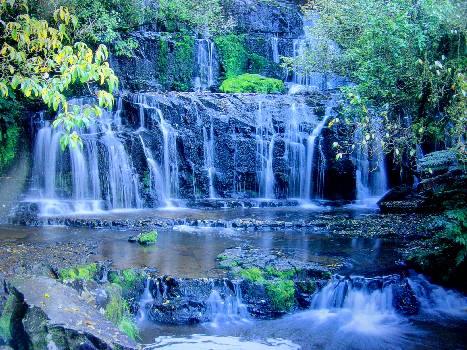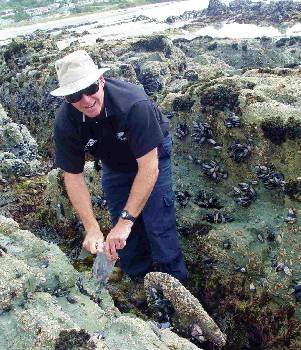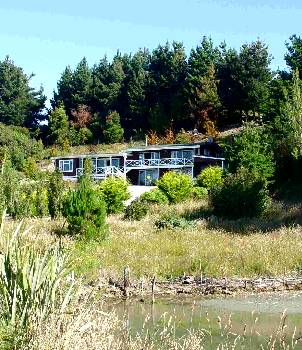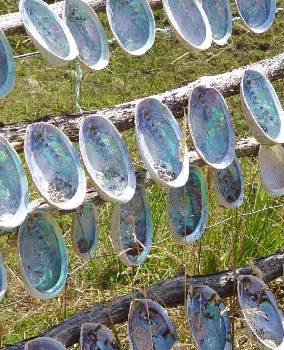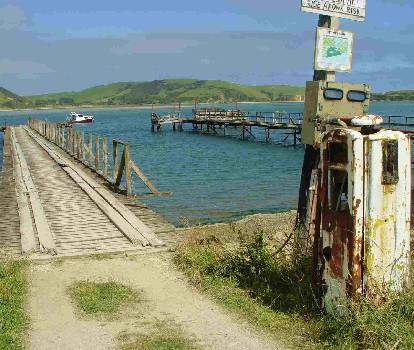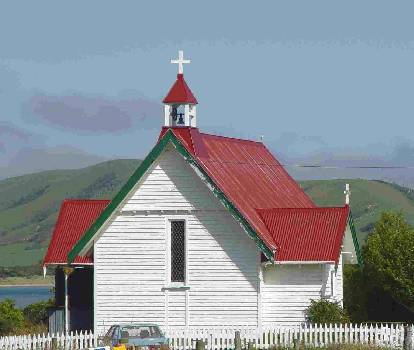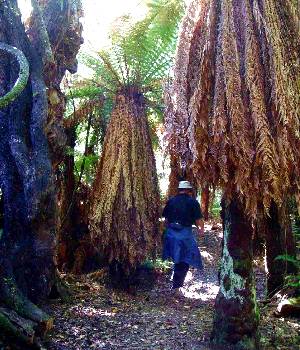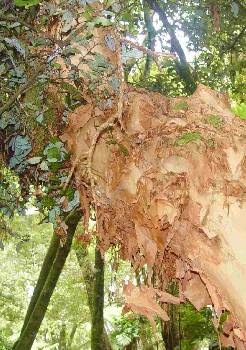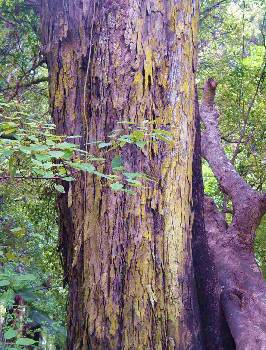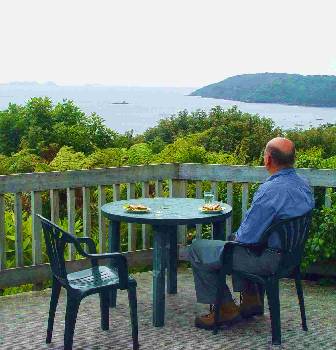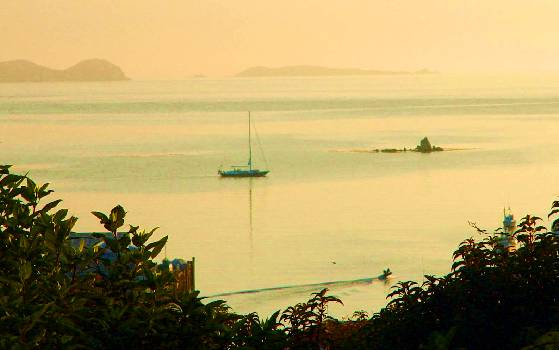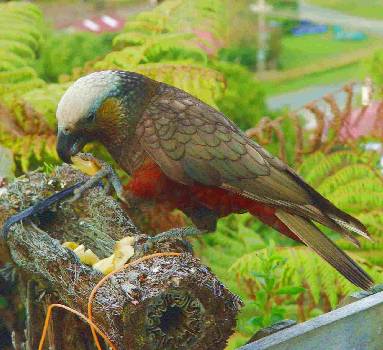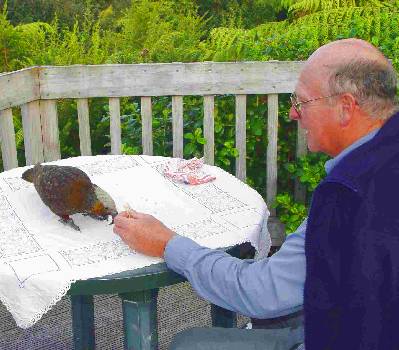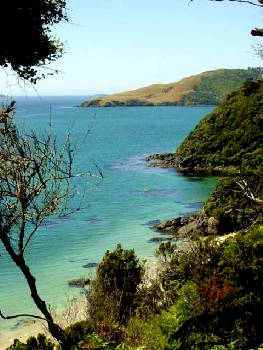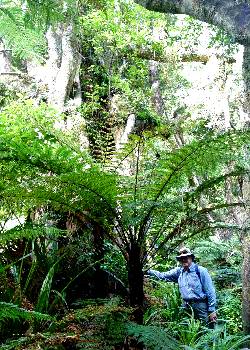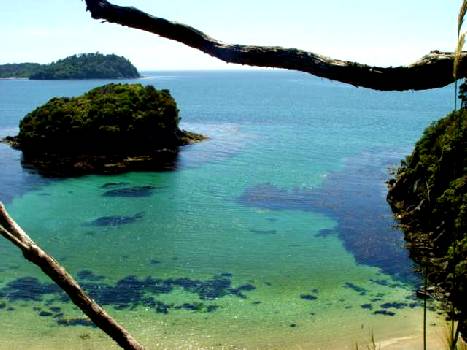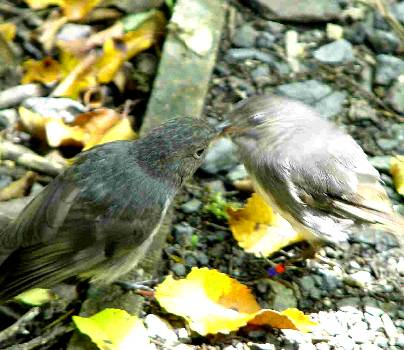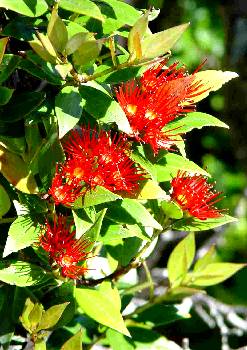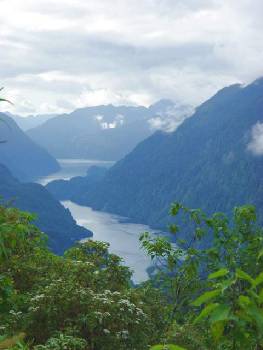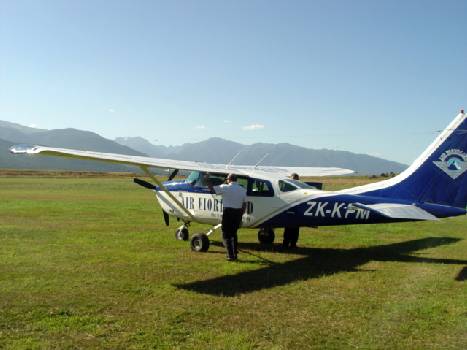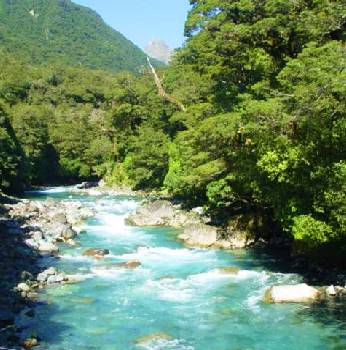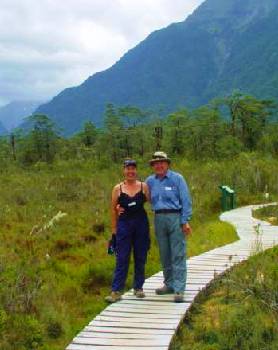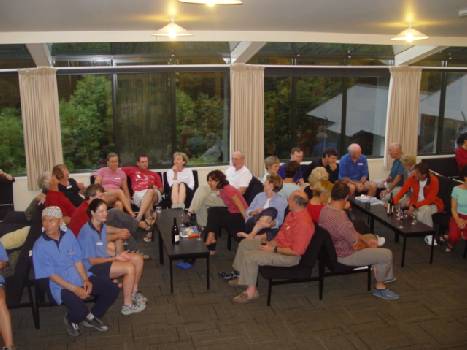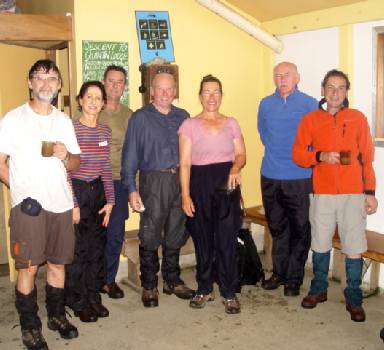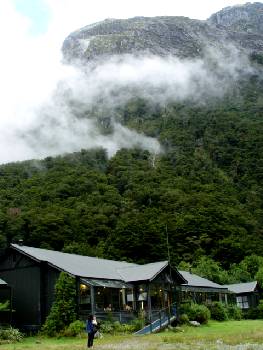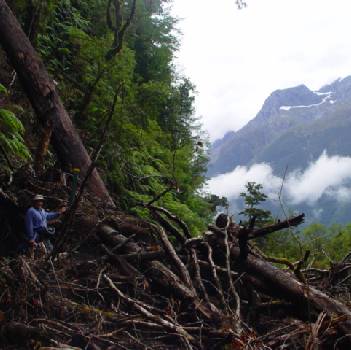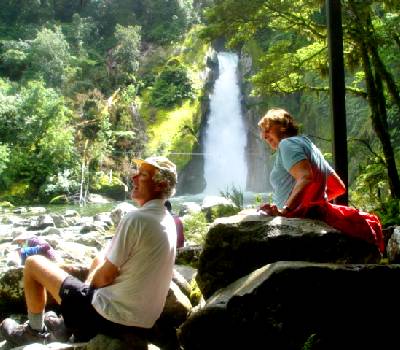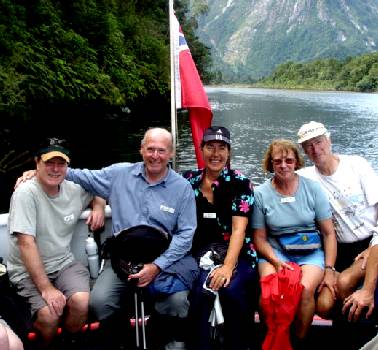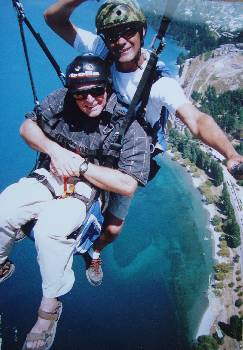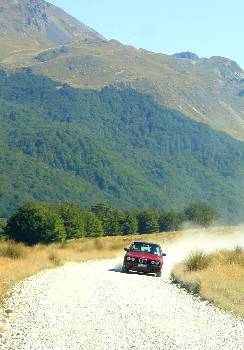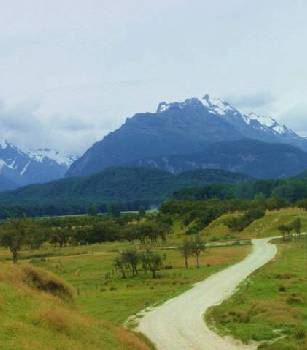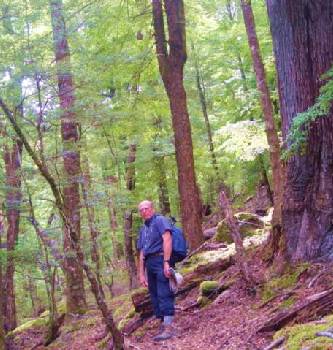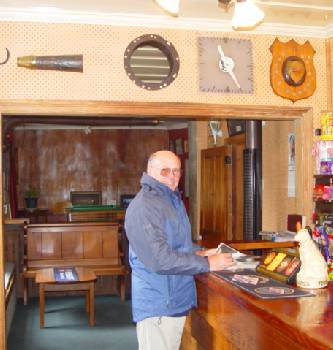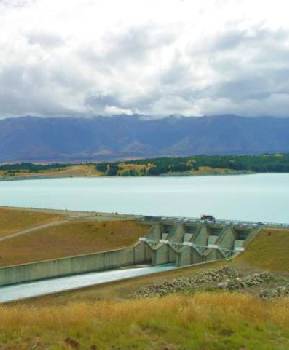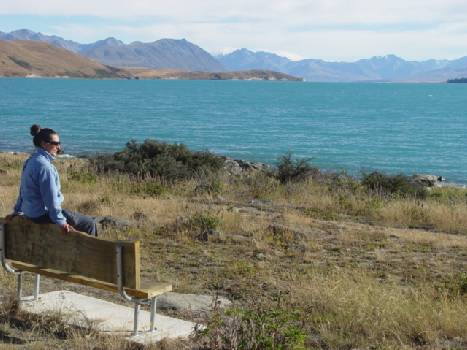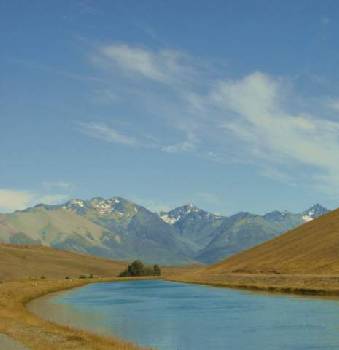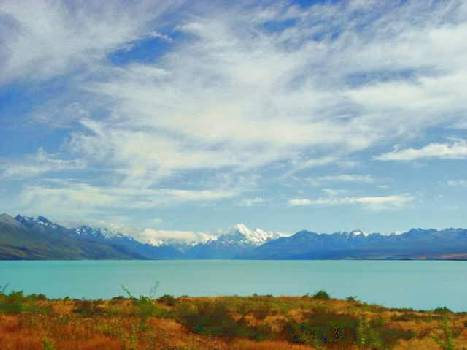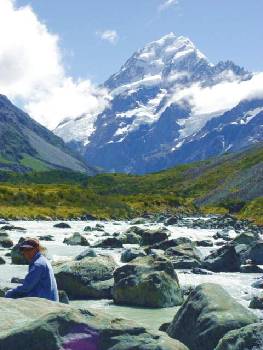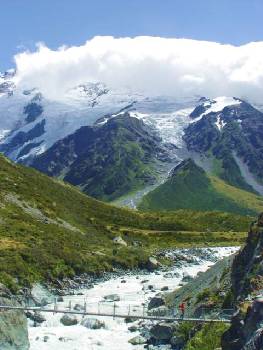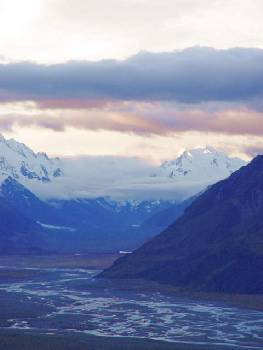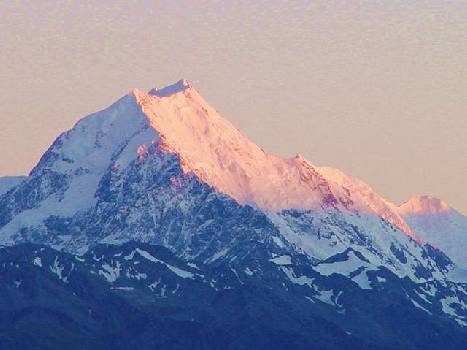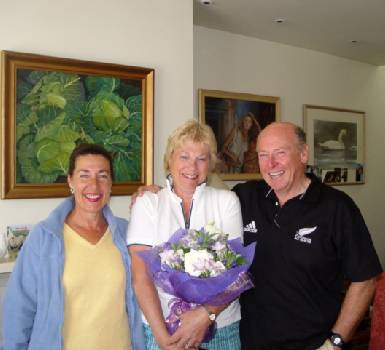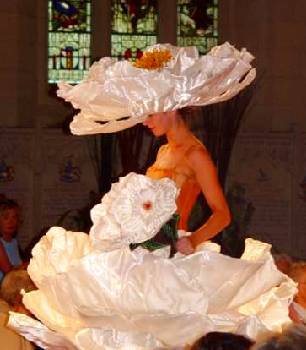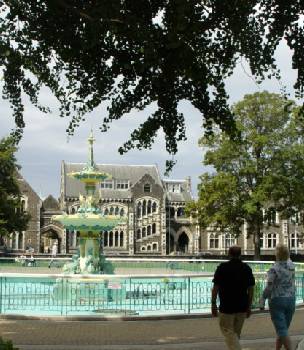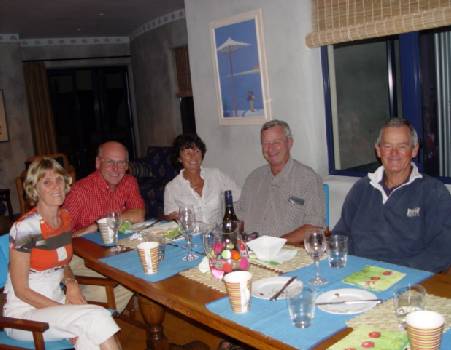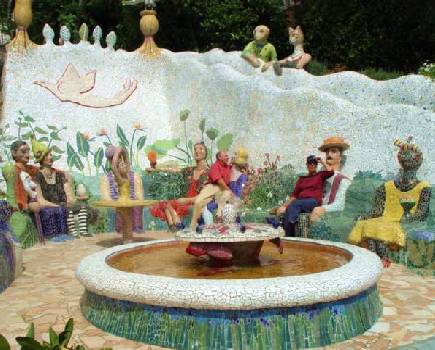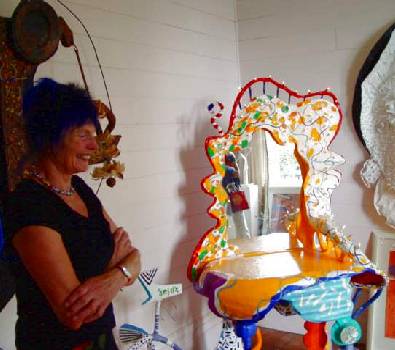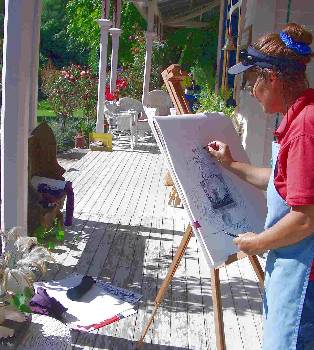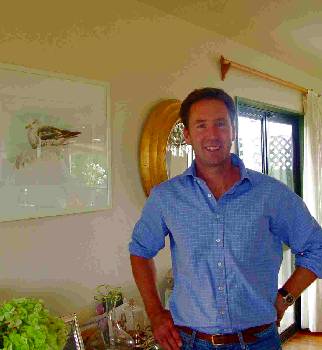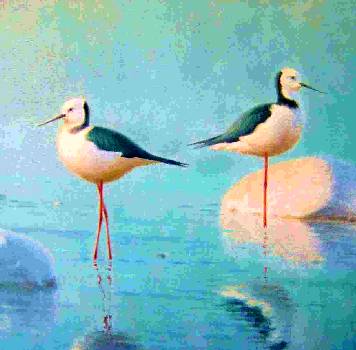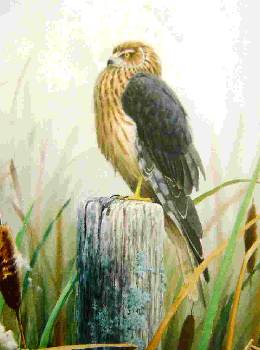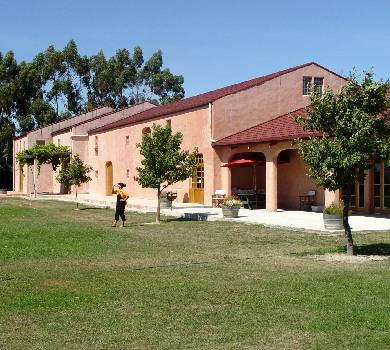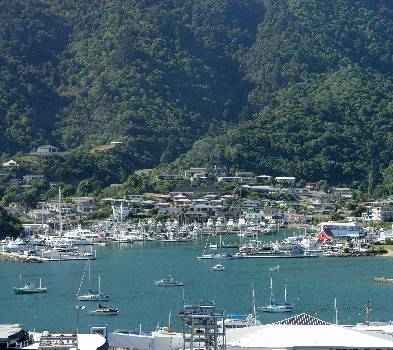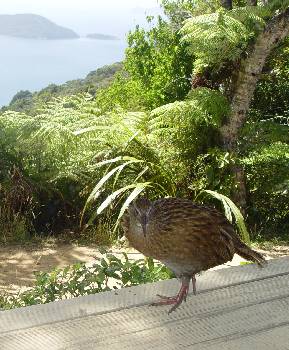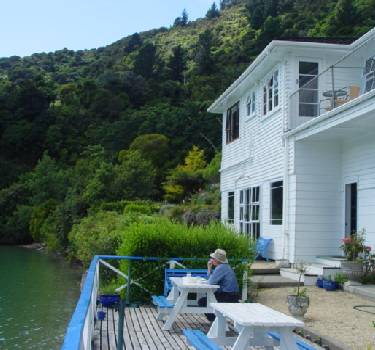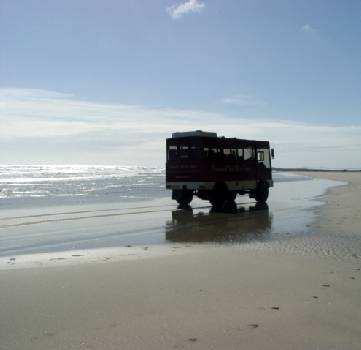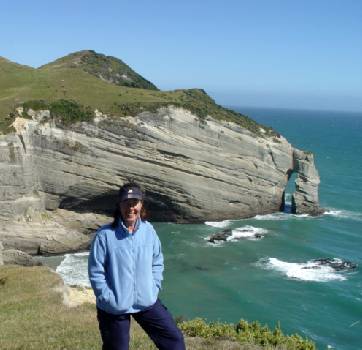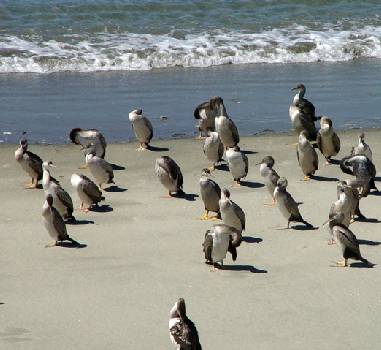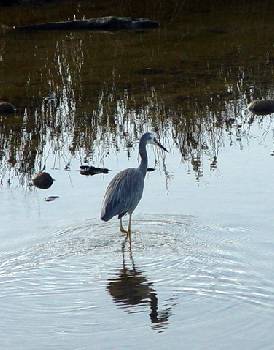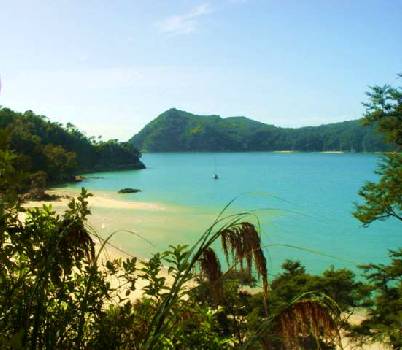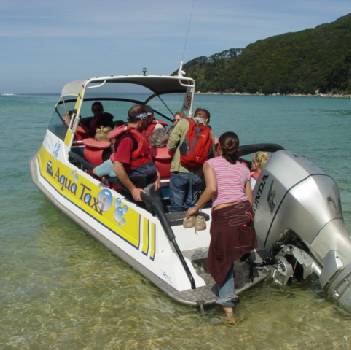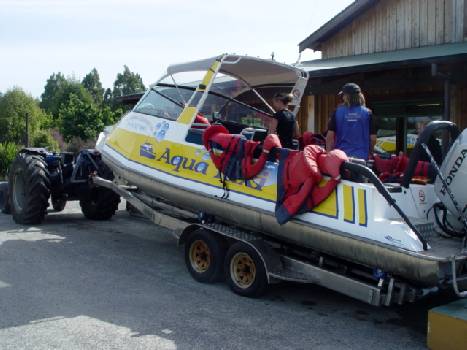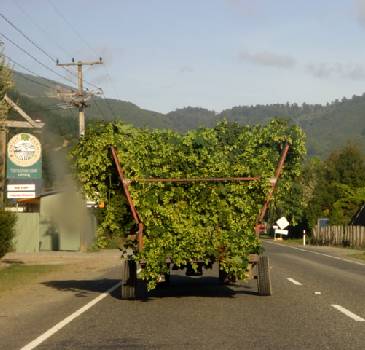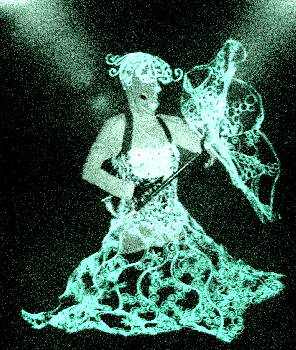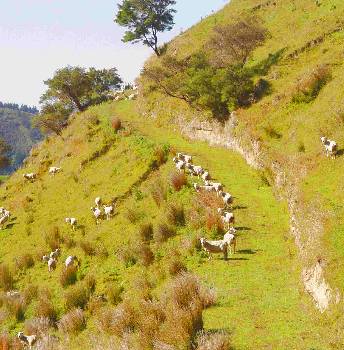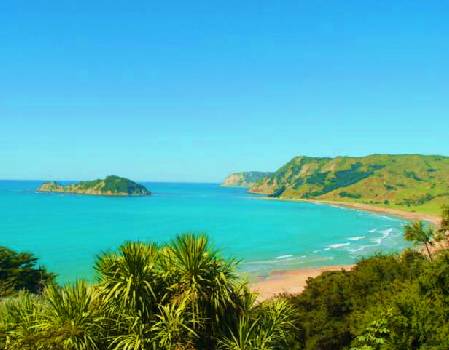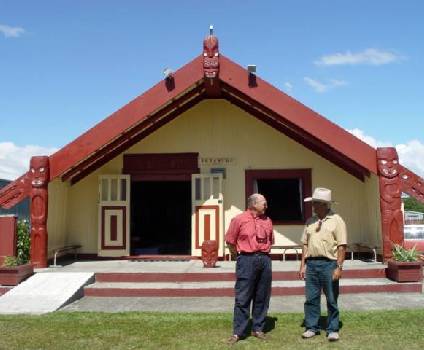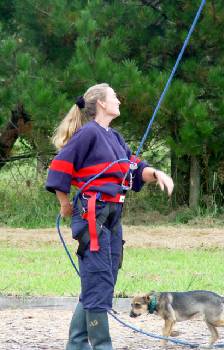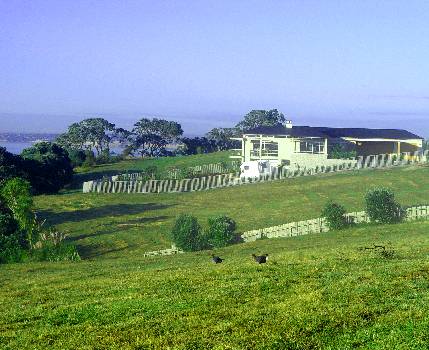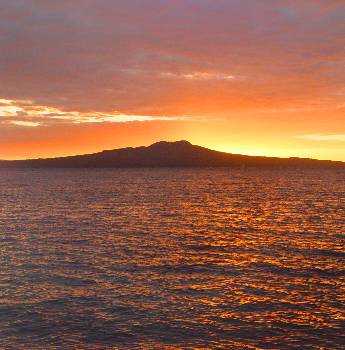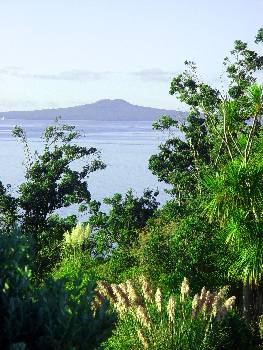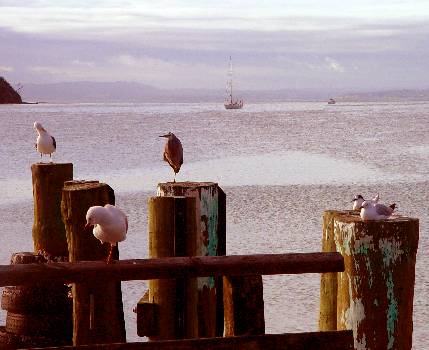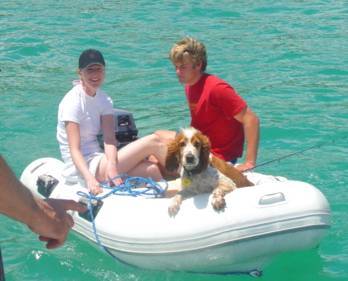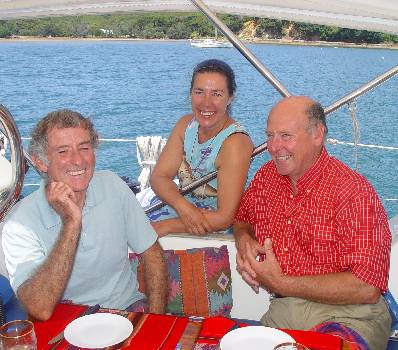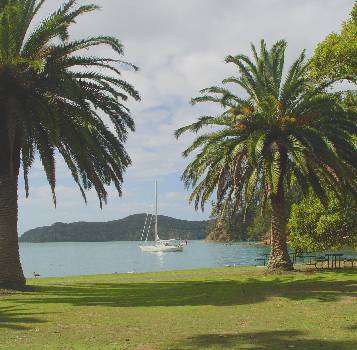| NEW ZEALAND - JANUARY 2005 |
| This is our 4 th summer in New Zealand, and we finally get to visit South Island properly. We debated whether to bring Kanaloa down and discover the beauties of the mysterious Sounds in Marlborough and in Fiordland. Stewart Island also pulls us like a magnet. The non-stop rain and wind of December 04 helped make up our mind however, and we chose to travel by car, and do a lot of tramping in the National Parks on the way down through North Island and over by car ferry to South Island. It was a wise decision, despite the fact that the weather improved no end, and we had non-stop sunshine and fine weather for the two months we were travelling. Travelling by car also gave us the opportunity of visiting many friends and acquaintances along the way, which enriches the viewpoint of the places we visited so much more, bringing to life and getting us involved in the life-style of each place. We certainly missed not having Kanaloa with us when we visited the coastal areas, but realised that New Zealand has to be visited by boat as well as by land in order to get the full picture of these wonderful Antipodean islands. Kanaloa was prepared for sea during the month of November and December 04, with just a brief sail up to the Bay of Islands over the New Year's Holidays to be with friends who live there. We returned mid-January, and almost immediately set off on our tramping expedition. NORTH ISLANDSampling the hot spring waters in our own private pool at Tokaanu near Lake Taupo for the first time was a great way to try out these thermal wonders of AETORAOA , New Zealand. Next day was to climb up to the crater lake of Mount Ruahepu (2800 Metres). The snow was still covering the peak of this volcano, which had last erupted as recently as 1995. The wind was so strong alongside the ski lift however, that we decided to stay down in the valley between the two volcanoes of Ruahepu and Ngaurohoe |
| |
| Mt Ruahepu |
| Waihohonu Hut |
|
|
| Mr Ngaurohoe It seemed that the tramp between these volcanoes, called the Waihohonu passage, was ideal for a day walk - with enough hills to climb up and over on the way as our first 17 km trek. A taxi dropped us off on the desert road on the far end of the track, and collected us on the opposite side, 8 hours later. The hotel we stayed in the Tongariro National Park at had a wonderful outside spa bath overlooking Mt Ruapehu for us to languish in at the end of the day - our poor sore feet were most grateful! |
| |
| Driving down the heritage trail to Egmont National Park was like travelling back to the pioneers' time. The twisty road through the Tangarakau gorge had been dug out by hand for the railways. All traffic previously had been by river. The Maoris benefited from this modern method of transport, and were enrolled to help out. Huge amounts of explosives must have been used to gouge out the tunnels through the mountainsides. The dense bush made progress very slow for the road workers, and deep-sided ravines took several men's lives, the work was so dangerous. |
| |
| Modern double trailers now replace railways between Mount Taranaki (above), Wellington and Auckland. We visit friends, Barry and Lydia at New Plymouth. Barry goes cray fishing with friends there and took David out early next morning to place some pots, and collected them the following morning, they got 5 in one pot, and none in the others! |
| Barry and Lydia's crayfish |
|
We visit Opunake where Lydia and he used to live. We're allowed to visit her Maori ancestral village there. Barry has many friends who gather in the pub. They all used to work for the only offshore gas processing plant which is situated close by.
|
| |
|
The Wanganui River is on the way between New Plymouth and Wellington. We stay one night at Omaka farm on the river to have a go at a half day's canoeing trip. The negotiation of the shallow rapids was enough for my sore arm to handle in one day! Other friends did a 4 day trip, and fell in!
|
| |
| |
|
|
| |
|
Stuart Robinson and his girl friend Renee were kind enough to accommodate us in their Wellington home. They were about to move house the following week, but didn't worry about putting us up and showing us around the capital of New Zealand. The Chocolate Fish restaurant was a favourite haunt of the Lord of the Rings film crew over the last 3 years where food was good and cheap!
|
| |
|
The Pohutekawa (NZ Christmas tree) was resplendent in its red flowers, seen from the botanical garden above. Wellington was dull and drizzly, but not too windy! Our return visit showed us windy Wellington as its name suggests! SOUTH ISLAND The smooth lunchtime crossing on the blue Bridge ferry to Picton allows us time to shoot straight down to Kairoura on the East coast, where we stay in a B & B and are given yet more crayfish! Next day we head down straight to the Catlins, south of Dunedin, the furthest South that the main road goes! Good walking on the deserted sandy beaches, and inland in the National Parks where waterfalls abound gives our legs a good stretch after a full day's driving. |
| |
|
|
| |
| |
|
|
| The blue mussels on the beach were abundant, but not as fine as the European variety. Our anchorage motel at Waikawa gave views right over the estuary, which would have been a main port for South Island, had it Dunedin not been settled before hand. Good to have trees identified in the area on some of the walks, finally I was getting the hang of some of the names of the flora! |
| Waikawa Old wharf |
|---|
|
|
| Wheki Tree Palm |
| Fuschia Tree Bark |
|
Mountain Totora tree bark |
| STEWART ISLAND
Hot and sunny weather is what we aimed at for this Southernmost Island of New Zealand, and it's exactly what we got! The 1.5 hrs crossing for passengers is easy in smooth seas, less pleasant when the Foveaux strait is suffering storm conditions, which it often is! We were able to rent a 3 bedroomed house overlooking Oban Bay for just $100. Below is Mithrandir, a friend's boat that just happened to be there at the same time as us. |
| |
| |
The local Kaka parrots come on the deck in the mornings and evening for their daily rations! Surprisingly they didn't like nuts or apples! Only bacon rind! |
| |
| |
| The visibility in the water was so clear we could see the blue cod swimming in the shallow waters. It's one of the best fish in the area, and very available from the wharf fish shop . 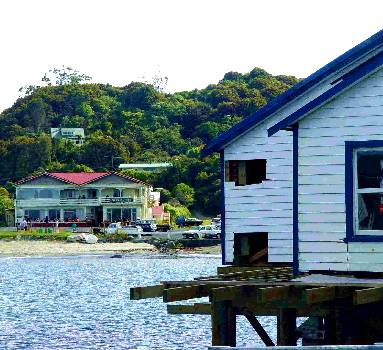 |
| |
| |
| Maori Bay's clear water |
|
Southern Robin |
|
|
|
Southern Rata There are hardly any roads here, and the round the island walk takes 7 days! We didn't have time to attempt that one, but enjoyed great views from the short day walks we did. |
| FIORDLAND
Fiordland National Park is one of the best preserved areas of New Zealand, the area takes up the South West corner of South Island and remains untouched by road. Main access is by boat. Doubtful Sound however feeds a power station for providing electricity to an Australian owned Aluminium smelting plant based in Bluff. Access is permitted to tourists, who can wonder at the achievement of cutting a road through this hard rocked terrain. |
|
Doubtful Sounds |
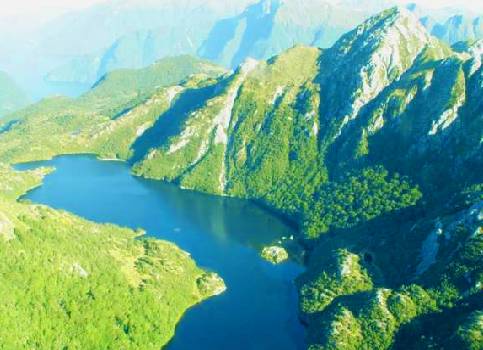 |
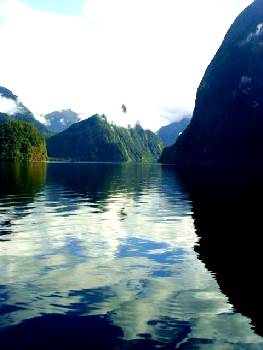 |
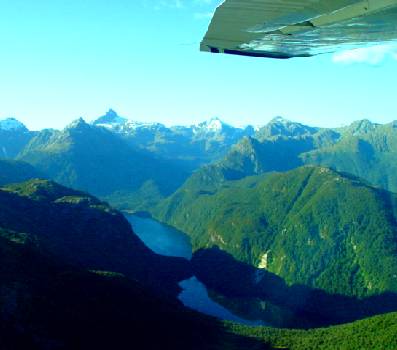 |
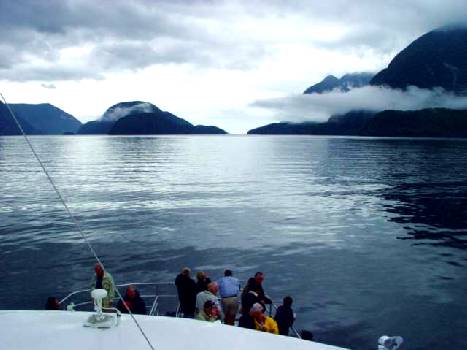 |
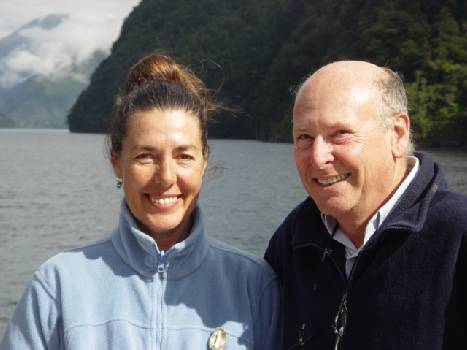 |

The trip with Real Journeys on Doubtful Sound was enhanced by being able to fly over it the following evening with Philippa & Christopher Turner , our friend from the UK we had the good chance of meeting up with whilst in Te Anau. Philippa is my Godmother's daughter, almost like a sister to me I've known her so long. They just happened to be on Holiday at the same time in the same place! |
|
The Homer Tunnel |
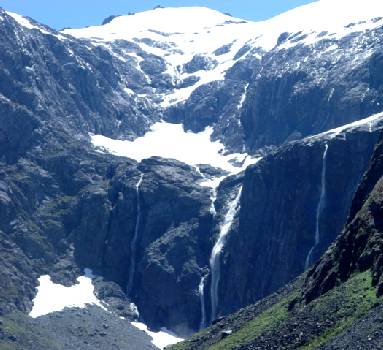 |
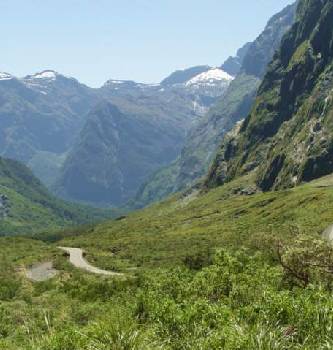 |
We crossed through the Homer Tunnel to Milford Sound in our own car before undertaking the journey by foot across the Mackinnon Pass on the Milford Track. MILFORD TRACKIt was a four day walk with three other friends, Rory McDonald and Margaret and Tony Beckett, all from Auckland. The oldest couple walking happened to be World Health Organisation Research scientists on Asian Bird flu, normally residing in Hong Kong. |
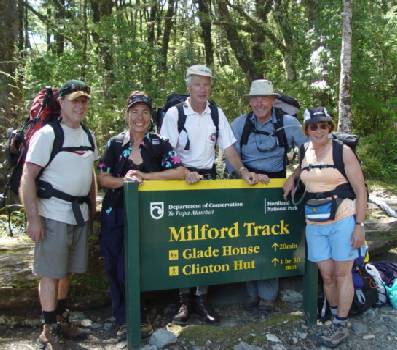 Rory McDonald, V, Tony Beckett, D and Margaret Horsburgh |
 |
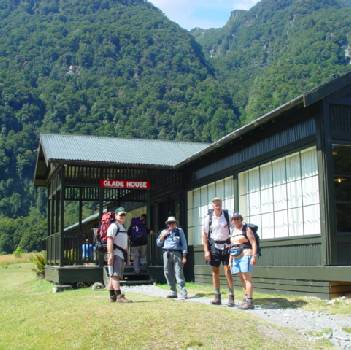 |
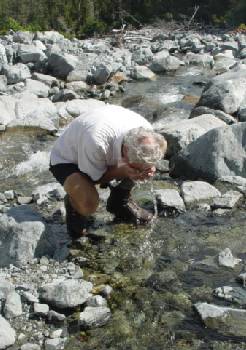 |
|
Glade House, the first lodge was seriously hot! We had to cool off in the river, and walk with Summer gear, with temperatures in mid 30C. |
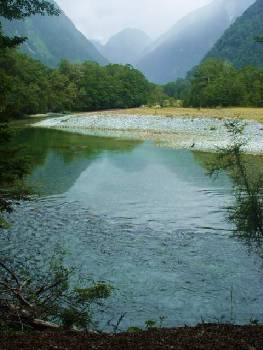 |
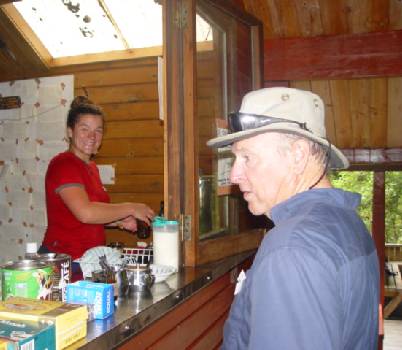 |
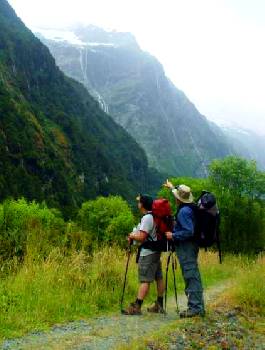 |
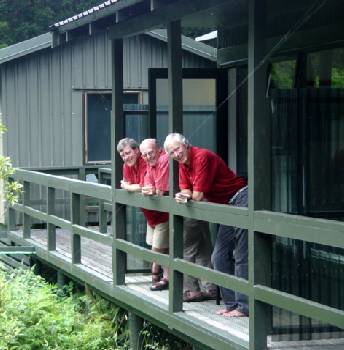 |
|
Pompolona lodge next day saw temperatures dropping as the rain poured down. Hot drinks at the midway hut at the top were most welcome! Camaraderie in the comfortable lounge was a good time to get to know fellow trampers, who were a very international bunch of people from Europe, Australia, USA and Japan. |
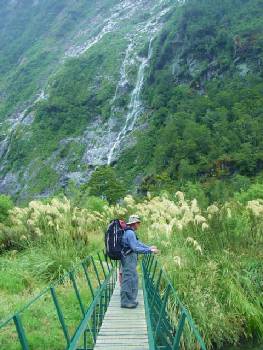 |
|
The zig zag trek to the top of the Mackinnon pass only took three hours, with a welcome hut at the top to have lunch and hot drinks. Descending the other side of the pass was like being surrounded by a circle of waterfalls. Sutherland falls (below). |
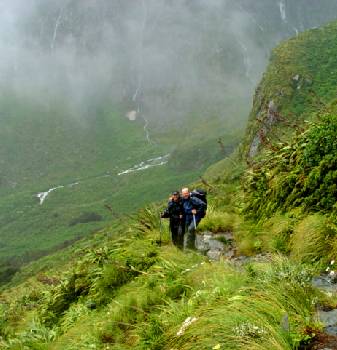 |
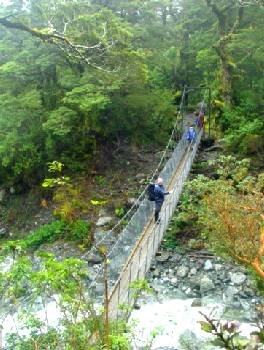 |
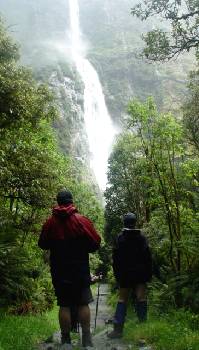 |
Great views and drying room from the Quintin lodge was as welcome as the good food and private bedrooms! |
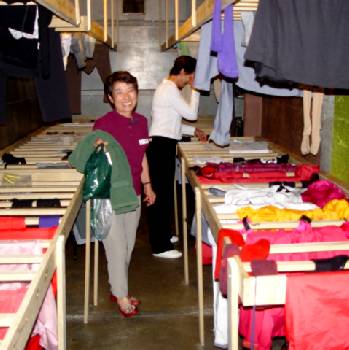 |
| Huge landslips were a frightening thought , tree landslides could happen at any time with the constant rainfall. Mosses abound in the moist atmosphere. 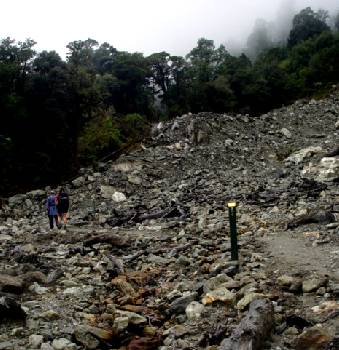 |
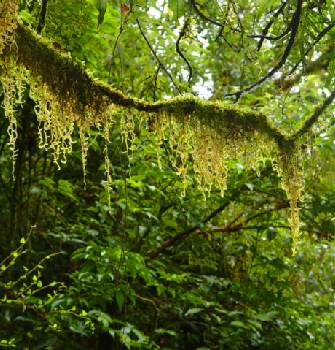 |
The tree roots have so little ground to hold on to, they tenaciously hang onto the mountain side until they have to let go and take the side of the mountain with them! |
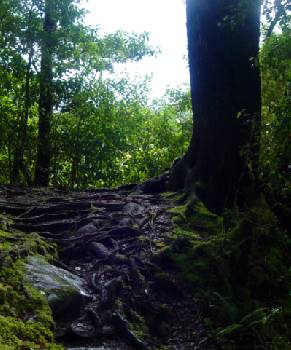 |
The final lunch break at Giant's gate waterfall tells us that we've managed four days without suffering any blisters, sore feet or legs! |
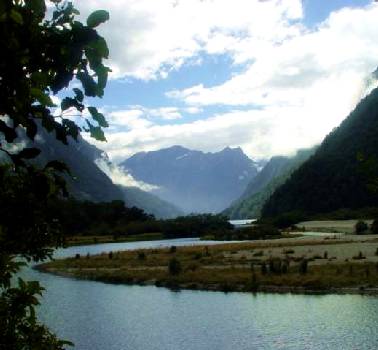 |
The Japanese members on our trek were the most colourfully dressed! The boat ride to Milford Sound was the last leg of the trip.  |
|
The Japanese contingent made us look drab by comparison in their colourful trekking clothes. Milford Sound with Mitre Peak looks simply wonderful from our hotel bedroom window. The whole trip was an experience worth having, for good company, good trekking and excellent accommodation and food. |
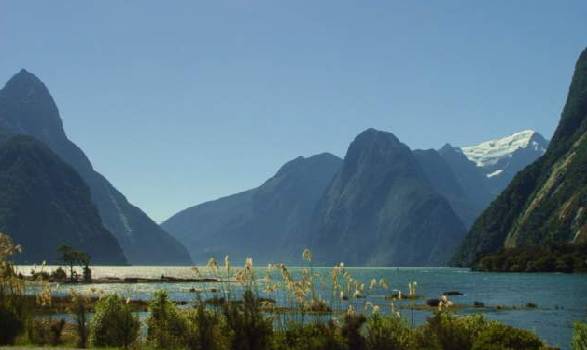 |
A 4 hour bus journey returned us to Queenstown , on Lake Wakatipu , where David did a tandem Sky dive for the first time in his life.
|
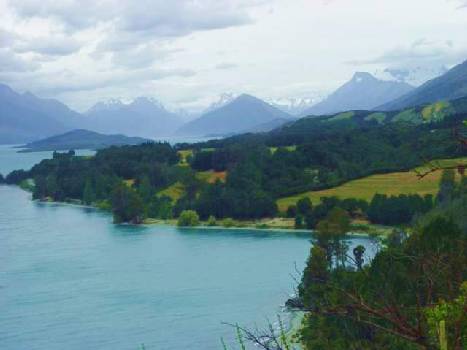 |
The Glenorchy road took us to the Lord of the Rings sites used for shooting Isengard, Lothlorien and Amon Hen. |
|
The dusty roads took us along the Dart river valley , where we could walk among the beech wood forests used for Lothlorien beech Woods . |
The historic Cardrona hotel offered a welcome log fire to warm ourselves up during the only rainy day we had on our way to Lake Wanaka. |
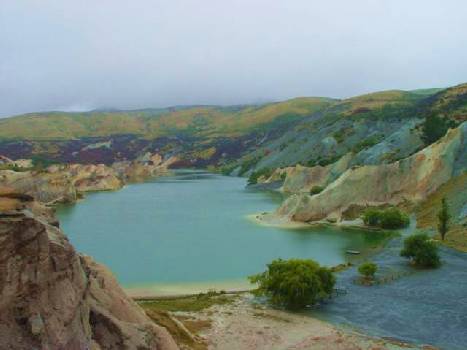 |
|
The gold mining site at St Bathans shows how the land was stripped. The Vulcan Hotel at St Bathans is a relic from that past time with its hole in the wall people have fun passing through! |
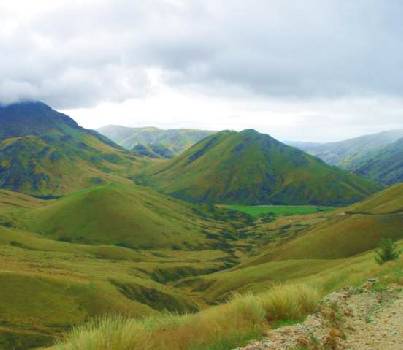 |
|
|
|
Lake Tekapo is this intense blue colour due to the glaciers that feed it. |
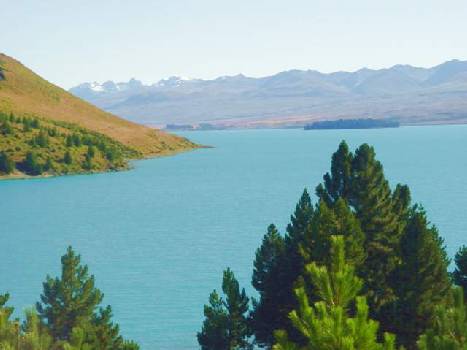 |
|
The Tekapo canal links that lake with Lake Pukaki , next to it, which is fed by the Mountains in Mount Cook National Park. |
|
We were fortunate to have this magnificent view of Mount Cook from the far end of Lake Pukaki . The drive along the left hand side took us to Glentanner Park, where we were able to stay and enjoy walking in the |
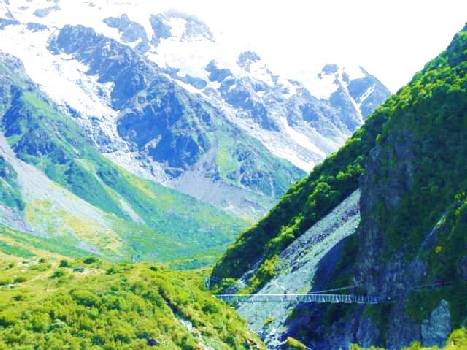 |
|
Hooker Valley, alongside the glaciers which feed the Hooker river descending from Mount Cook and Mount Tasman. |
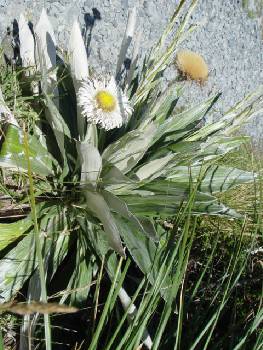 |
The Mount Cook Daisy is among the many plants that survive the harsh climate. There were three other swing bridges on this walk, fabulous facilities for the trekkers to enjoy such magnificent scenery. |
The Tasman valley here is nearly all gravel bed now, even the glacier is embedded with the gravel from Mount Tasman. |
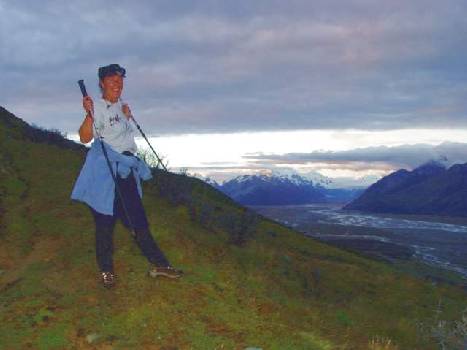 |
We climbed to the top of the Glentanner hill farm where we were staying to get this magnificent view at sunset. We ran down in the last of the light, using our sticks so as not to fall over on the gravel tracks. That morning we had climbed up this Tasman valley with its gravel laden glacier in wind and rain, it was the coldest we'd been during the whole trip, and decided to turn back early deciding that we're out here for fun, not miserable conditions! |
Mount cook looking resplendent at sunrise next morning. It used to be 100 metres higher, but the top collapsed and carved away this steep right hand side about 10 years ago. The Mountain is still rising, but due to the loose construction of the rock is constantly lowering itself again! |
 |
We stopped on our way to Christchurch to view more lakes in the middle of sheep farm country. Ricky Dillon now lives in Christchurch, she was just celebrating her Birthday. Ricky used to be our friend and neighbour in Hertford, England for 30 years. It was great to catch up on her news and have her show us around this wonderful City, with all its historical features. |
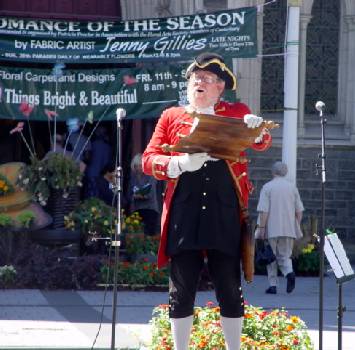 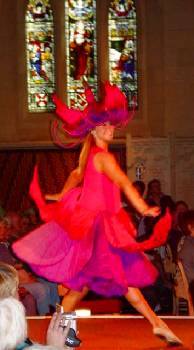 |
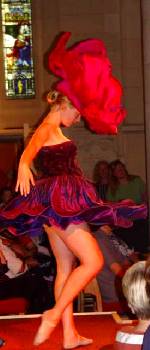 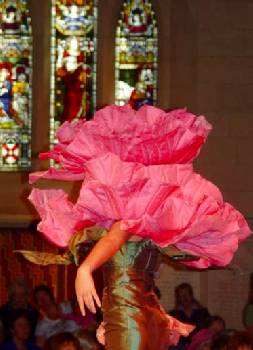 |
There was a flower show happening in Christchurch Cathedral . A most spectacular show of hand made costumes depicting almost 50 different flowers were paraded in front of the audience. |
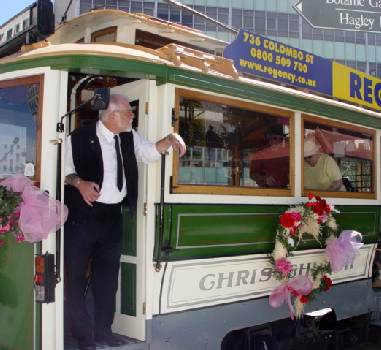 |
Even the trams were bedecked in flowers . Ricky took us around the Botanical garden, which backs onto Christchurch College , the main university of the town, where many of Ricky's family had been educated. Her family had been running a sheep farm for five generations in the Northern part of South Island, near Blenheim. |
Our friend Jim Wallace had also been to this college. We met him with his Australian wife Jo at their home in Sumner, which is Christchurch by the sea. We had originally met Jim and Jo 4 years ago in Tahiti on their motor cruiser, Atlas, together with their friends Penny and David . It was a great opportunity to meet up with them all again in their home town. AKAROA |
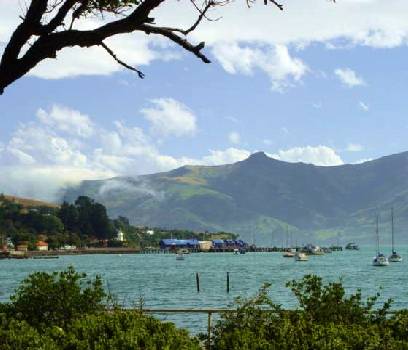 |
Jo took us along to Akaroa, on the Banks Peninsula. The port of Akaroa is nestled inside the volcanic crater, a wonderful site, thought the French who settled there before New Zealand was negotiated as belonging to the English Crown with the Maoris! It still retains a good deal of French style and has good restaurants to prove it. |
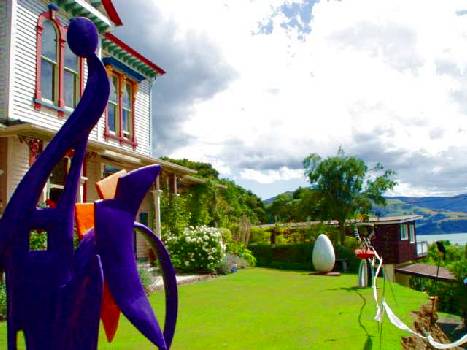 |
A good deal of creative power is capture in this area, and Josie Martin is no exception. Her sculptures and mosaic garden is extraordinary, after the style of Gaudy and other surreal artists. She runs a bed and breakfast at her house, called Linton . I was so taken with Josie's captivating enthusiasm for her work, that she persuaded me with David's encouragement to go along to her painting class due to take place at the beginning of April. |
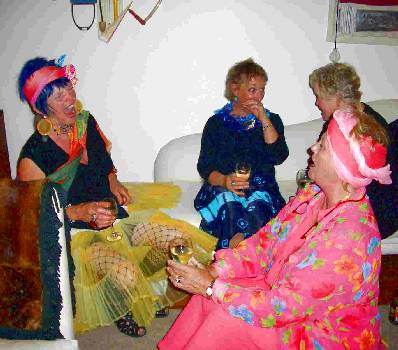 |
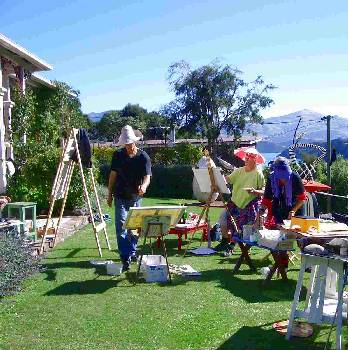 |
Ricky came along with me, she's almost as mad as Josie in her manner of dressing ! We had a great time learning more about making colours, trying to capture shapes and poses with the life model she used and letting our imagination take a hold, letting go of conventional ideas. NELSON LAKES AND BLENHEIM |
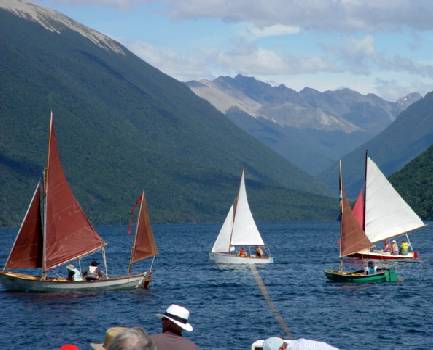 |
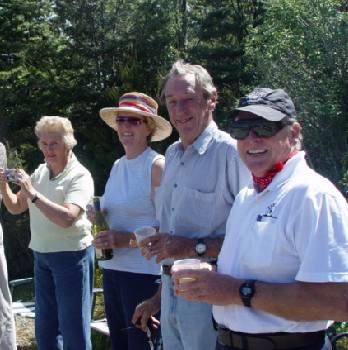 |
Part of Ricky's huge family live in Blenheim, Richard and Liz Dillon , where they own vineyards for supplying grapes to Villa Maria, one of the top New Zealand wineries. They arranged to meet us for a picnic up at Lake Rotoiti, in the Nelson lakes area for a vintage small boat show. A very good showing of older cars on display such as the Delage were of particular interest to David. A perfect Summer's day made a good family day out for 'kiwis' mucking about on the water, and socialising with friends who'd come from all over South Island, and some even from North Island. Whilst in Blenheim Richard Dillon's son, Nick is a superb bird artist , and allowed us to visit him at home and enjoy looking at some of his wonderful work, such as the pied stilts and the NZ Hawk below. |
|
Nick Dillon |
|
Ped Stilts |
NZ Hawk |
Blenheim |
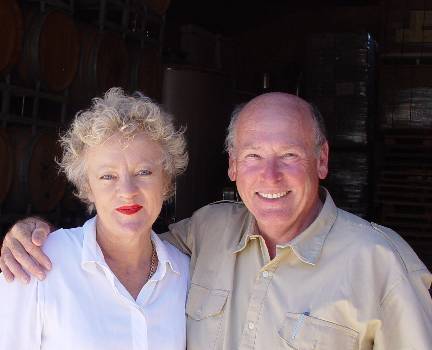 |
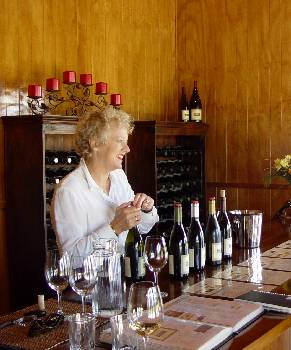 |
A close neighbour of the Dillon's in Blenheim are Isabelle Estate Winery owners Robyn and Mike . The quality of their Pinot Noir is outstanding, and they excel in Sauvignon Blanc, Chardonnay and Pinot Gris also. We met them on their boat 2 years ago whilst we were in Musket Cove. Robyn treated us to a wonderful meal with the help of her daughter, whilst they were both so busy giving customer tastings. Their main business is export to the USA and Europe, only selling 5% of their produce within New Zealand. MARBOROUGH SOUNDS |
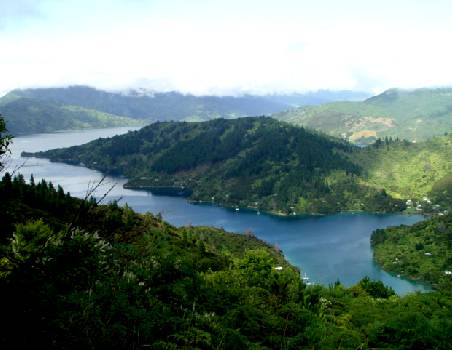 |
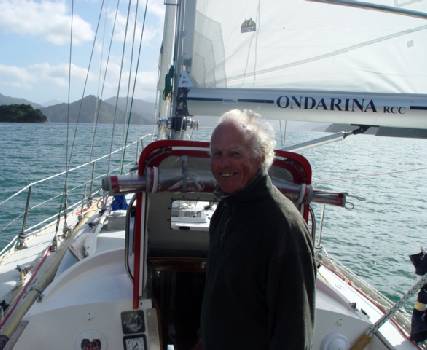 David Mitchell , a friend whom we'd met 4 years ago in Tahiti invited Richard and us to join him on his boat, Ondarina, which he'd just sailed down to Picton from Opua in North Island. |
Picton It gave us an opportunity to enjoy sailing the delights of the Marlborough Sounds for the day, as well experience the fickle winds screaming down from the mountain tops into the deep sounds. We walked the length of the Queen Charlotte track, about 90 kilometres over a period of 4 days in fine weather, staying in resorts and lodges along the way, great views and hill climbing! |
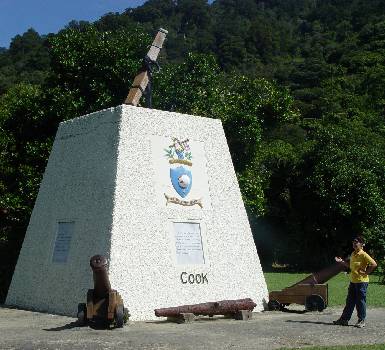 |
 |
Captain Cooks memorial in Ships Cove , where his boat Endeavour stopped on three occasions to revictualise from plants left in 1770 This Weka is a tame flightless bird, a relative of the Kiwi. There are many of them in the bush, they are so tame thy might get inside our rucksack and get taken away by surprise! |
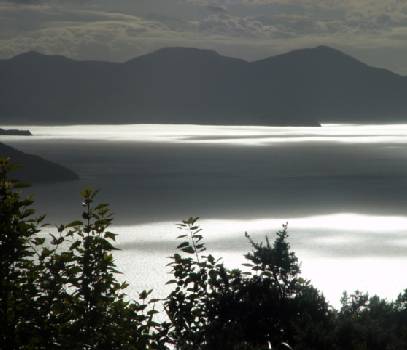 |
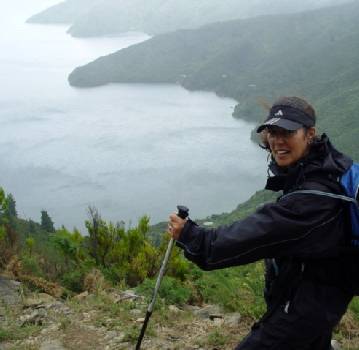 |
 |
This deck of the Te Mahi hotel collapsed the following month during a wedding reception! CAPE FAREWELL PENINSULAA specially made bus that doesn't sink in the shifting sands took us all the way out along this 26km long sandspit, that stretches out into the Tasman Sea. |
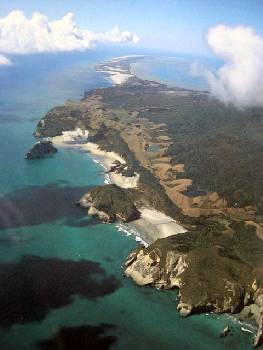 |
|
 |
It is having sand deposited on its far end at the rate of 1 metre per year, and some yachts are not aware of how easy it is to be grounded on it when trying to round it before turning South. The bird life in the early morning is prolific, feeding on the shellfish as the tide retreats. We had to catch this tide at 5 a.m - just before dawn. To see the shifting sands, this desolate place had many surprises, such as extraordinary sand patterns. |
|
Pied Cormorants |
White cheeked heron ABEL TASMAN NATIONAL PARK The allure of this area can be seen by the gorgeous turquoise coloured water and long white sandy beaches. It's a two day tramp to do the whole park, we chose to do just one day, walking out from Marahau along the coastal track to Bark Bay. |
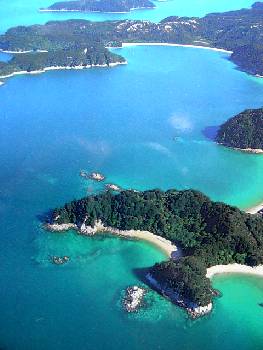 |
|
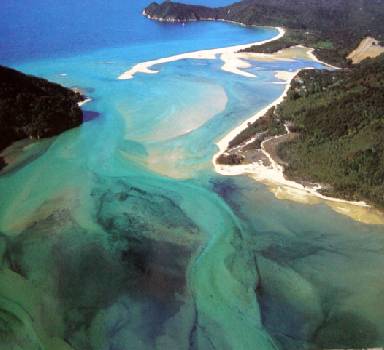 |
As the tide came in, the colours of the sands were a pallet of shifting colours, a delight to the eye. |
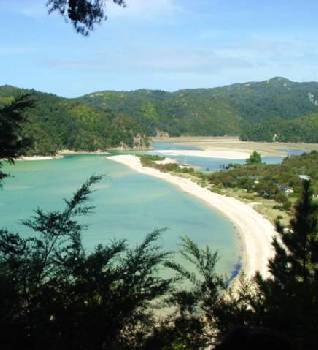 |
We arranged for a water taxi to collect us from Bark Bay. The taxi rides onto the tractor trailor and we are all driven back to the Marahau Village! This is also the preferred method for the fishing boats where there are no protected harbours, both in North and South Island. |
 |
The Maori carvings in that village are on display in a museum cum souvenir shop. Splendid examples of their skilled craftsmen. The Maori population of this Golden Bay wa estimated at up to several hundred. This was after the conquest by Te Rauparaha and his sub tribes from North Island in 1827. European settlement and the Treaty of Waitangi brought a cessation of these traditional inter-tribal hostilities |
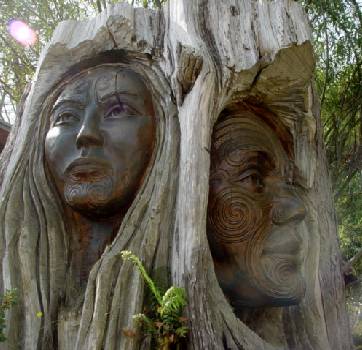 |
This area between Nelson and Motueka had plenty of tractors bringing in the hop harvest. It's used for fermenting into beer. |
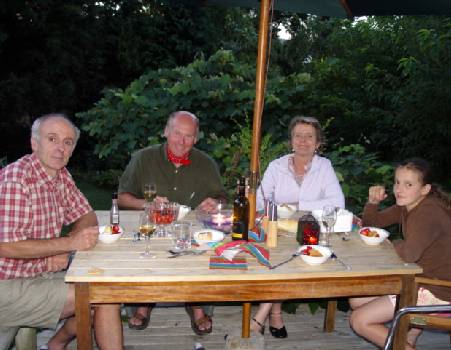
Whilst we're in Nelson , we had the opportunity of meeting up with other sailors who live there now, Anthony and Catherine with their daughter Jessica and Eleanor. Jessica's pink parrot was such a cuddly bird, he would come and sit on our shoulder and nibble our ear even though he hardly knew us. |
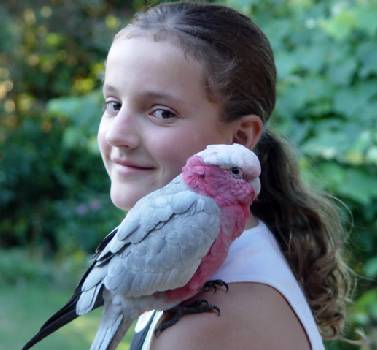 |
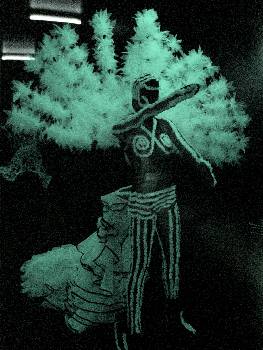 |
|
Nelson is the venue for the wearable arts museum . The creativeness of the costumes made from anything that the artist can think of has to be seen to be believed. These fluorescent ones give an idea of how clever some of the outfits were that are in the Museum. Some are made from tin cans, the bottoms of plastic bottles, ironmongery, or an assortment of anything that can give good texture and patterns. |
NORTH ISLAND We returned to North Island six weeks later, driving up the Eastern side, to visit our friend Bob Bell whom we had not seen for two years. He owns Condor or Bermuda, which was a winner of the second Round The World Whitbread race back in the 1970's. He and his wife Heather own a 7,500 acre sheep farm at Akitio, about 1 hours drive towards the East coast from Danniverk. |
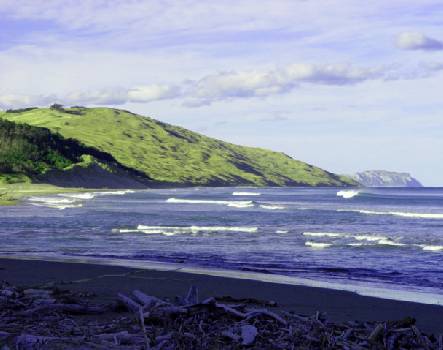 |
Whilst he had all his UK family staying with him in November to celebrate his 60 th Birthday, he turned over his enormous Caterpillar bulldozer, with him underneath it! He was lucky to get away alive. There had been so much subsidence of the dirt road alongside the river that he was driving on, that it gave way. The bulldozer slowly slipped towards the river, then turned over, with just a small tree preventing it from tipping straight into the river! It was his lucky day, he could have been thrown out, and taken away into the river and out to sea. The debris along the shore shows how much gets washed down by the river. |
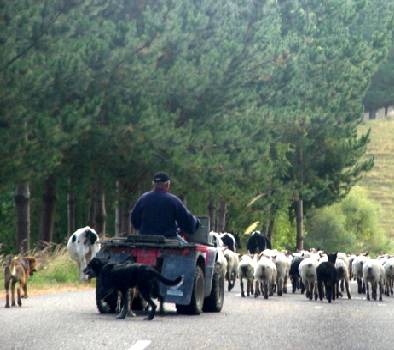 |
This whole central area of NZ is devoted to sheep and cattle. Bob's hill farmland hardly has any flat areas, the quad bikes are an essential tool on these tracks. EAST CAPEFrom Gisborne eastwards is a huge landmass that most New Zealanders hardly ever visit. This is true Maori land - the coastal area has been claimed purely by Maori tribes in exchange for the inland area which is now mainly National Park. The Maoris have taken the lead of the 'Pakeha' (white man) here, using the land for grazing sheep, cattle and forestry. They have no good harbours, but as they used to use only the large canoes for warring purposes, these are brought up on the beach. |
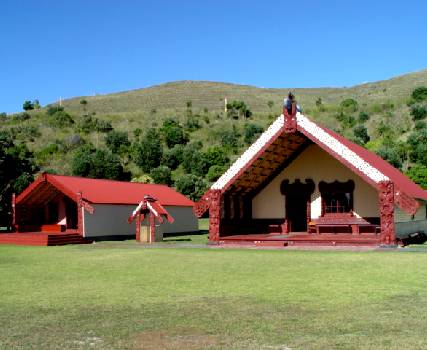 |
 The film called 'Whalerider' was made two years ago in the first settlement after Gisborne. It was nominated for Oscars at the same time as Lord of the Rings, so didn't quite make it. The story is about a Chief's daughter, who was not allowed to lead her tribe. She proved herself worthy of the title, by having a great rapport with the whales. She got the whale to bring in her father's 'whaka' (canoe) when it was foundering in heavy seas. The canoe and whale have been depicted at the Marae. |
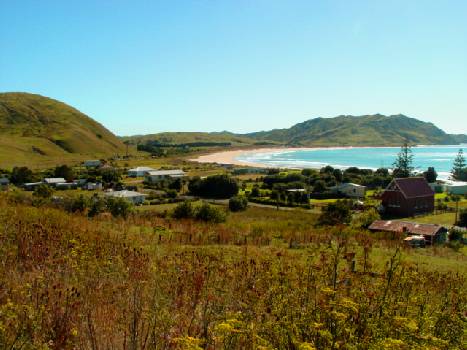 |
Cattle grazing on the shore, fruit growing in everybody's gardens. The Maoris here are very self sufficient, and hardly need to go to the big towns, which are 6 hours drive away for many of them. |
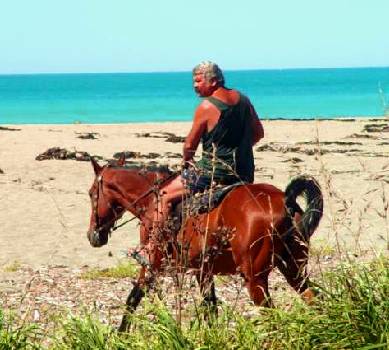 |
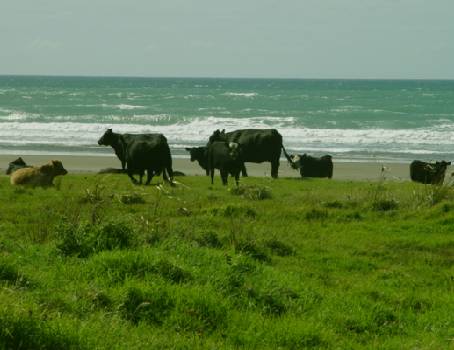 |
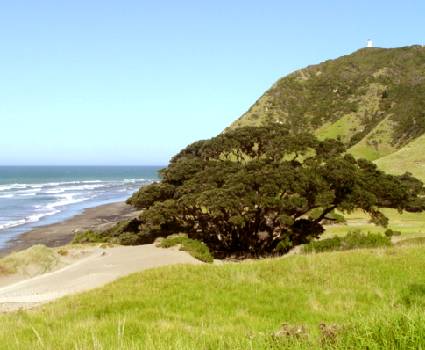 |
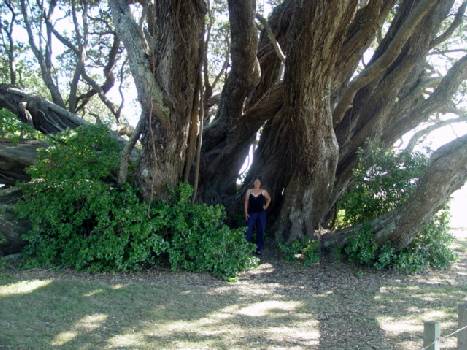
Pehutekawa trees like this one at East Cape have grown so old, that the one I'm seen in the middle of is estimated as being 350 years. Old. |
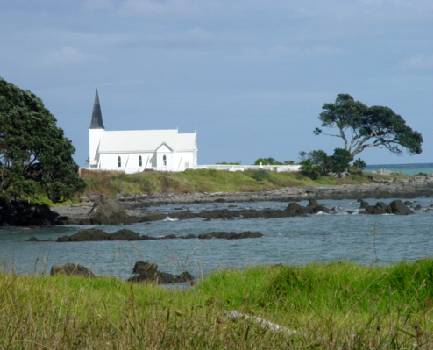 The Maoris use these Presbyterian churches in each village as well as their meeting houses. |
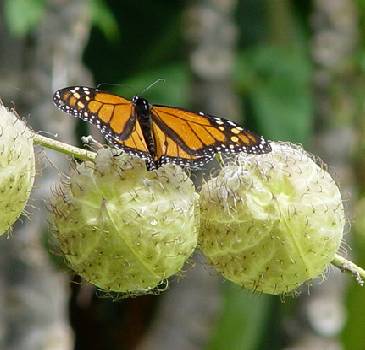 |
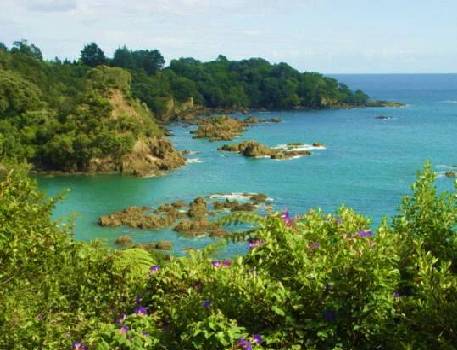 |
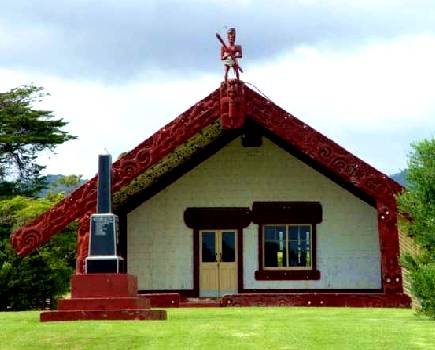 |
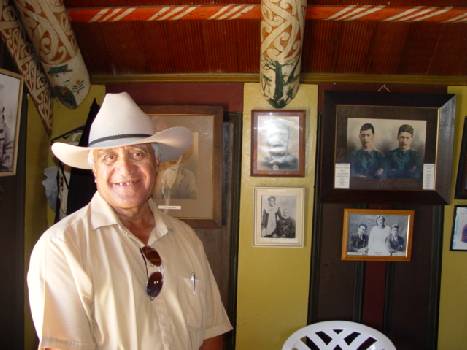 |
This Maori invited us inside the meeting house, where his family photos are prominently on display. The floor was covered with mattresses for the visitors who were due to stay that night after a Church gathering. His mattress was beneath his parents photographs. Whitiangi - High ZoneFriends, Geoff and Penny and their two girls, Hailey and Astral had just moved to this lovely colonial house in Whitiangi to run a High Zone business, where you are held by a rope and harness as you walk on the tight ropes on the top of the tall poles. Astral, just 7 demonstrated! They have exchanged their life afloat for the good life, with a few cattle, sheep, pigs and a goat as well as a few ducks, cat and a dog! |
 |
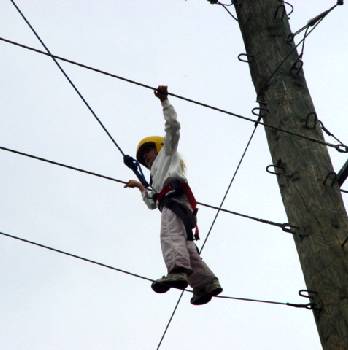 |
HAURAKI GULF - JANUARY 2004 |
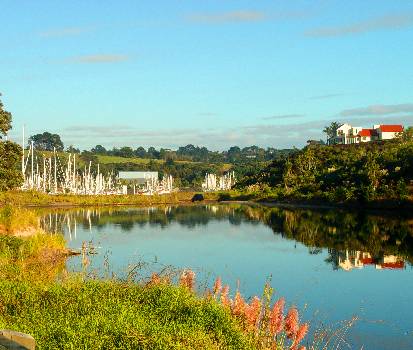 |
Kanaloa has been using Gulf Harbour Marina for the last 3 years. We shared our pontoon with Alan and Driek Lockie , who had this house built on the cliff, |
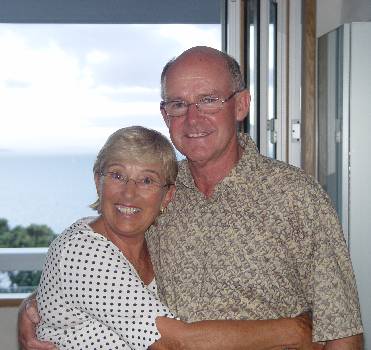 |
Great views over the Hauraki gulf, including Rangitoto , the Volcano that erupted 200 years ago, and a feature of the Gulf now. |
|
over to Rangitoto, (above) and Auckland. |
The bird life is around us on the pontoons and the parkland all the time, and it's a great place for walking. |
 |
Concie and Rolly Lennox-King, here at their batch in Te Unga Bay in the Bay of Islands, and their daughter, Olivia plus her boyfriend Reagan and doggy Caesar . This wonderful family have been great friends to us whilst in NZ for the last 4 years, and introduced us to many of their friends and family. They are now living aboard their own boat, Restless in the Caribbean, and will be living our life-style only in the Northern Hemisphere for the next 5 years or so. |
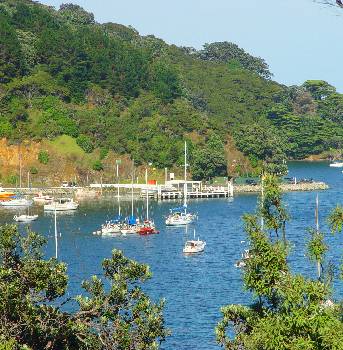 |
The best encounter was here at Tryphena Harbour on Great Barrier, where we met Eddie Anker, an old friend from 1959! Neither David nor he recognised each other, but deducted by talking to each other that he used to be David's brother's best friend, and they used to take Eddie on family picnics together! He is currently living in his house nr Hastings, North Island and sailing the boat he built himself around New Zealand. |
|
Kanaloa anchored in Mansion House Bay, Kawau. One our favourite anchorages in the Hauraki Gulf. The historic house was built in 1870's and has a well planted botanical garden, together with peacocks and wallabies in the woods. |
 |
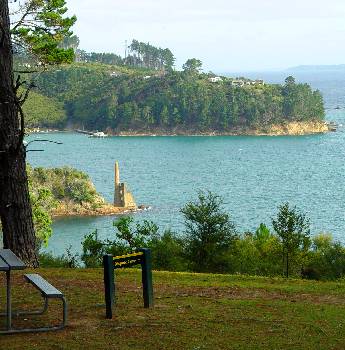
The old disused copper mine on Kawau shows how nicely placed some of the houses are in the background. |

